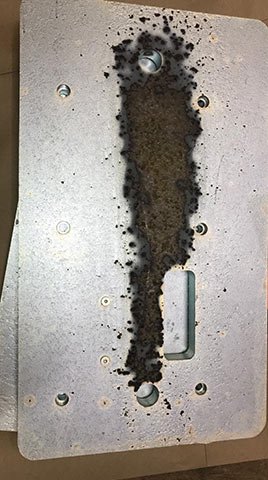The Poor State of Substrate


Do these pictures look all too familiar? These images demonstrate a lack of zinc coverage due to poor substrate and excess surface contaminants.
When steel parts have excess surface contaminants such as heavy scales, weld flux or oils, the chemistry in an electroplating process may not be enough to effectively clean the product and allow for proper zinc adhesion. These excess surface contaminants can be remedied in a couple of ways, but let’s first go through what can cause this to occur.
There is a reason that zinc plating works best with steel product, and that is due to the iron in the surface and its magnetic capabilities. Surface contaminants are neither magnetic nor contain iron which means iron which means they are not able to be plated with zinc. This is why all products must first go through our aggressive cleaning processes to remove anything on the surface and prepare the material for zinc adhesion.
Surface contaminants are created in the various processes that come prior to zinc plating, including the welding of components and brazed fittings, heat treating, hot rolling and more. When parts are heated to a certain temperature, heavy scales that are inherent to the process can be baked into the surface of the product when exposed to high temperatures. Here at Plateco, we have our cleaning built directly into our fully automated production lines, and while we have very aggressive cleaners that are capable of removing almost all surface contaminants, there are some that are more difficult to remove in the first attempt.
As mentioned previously, there are two options for product that has an abundance of scale or surface contaminations. One option is to simply clean or process the product a second time. One time through the standard electroplate cleaning process may not be enough, but a second run through may just do the trick!
The second option is to first clean the product with an abrasive cleaning process that we can perform in our mechanical galvanizing barrels prior to zinc electroplating. As opposed to our automated electroplating production lines, mechanical galvanizing is a manual process where our skilled operators are able to strengthen the concentration of our cleaning chemicals at a moment’s notice to ensure that surface contaminants are removed, and product is cleaned properly. In addition to the chemicals, there is media (glass beads) that can be added, coupled with the rotation of our barrels and the part-to-part contact act as a type of scrubbing, physically removing the scale from the surface of product.
If you have witnessed these substrate issues in the past or currently, fear not. There may be a way for us to remedy it and provide you with the quality you are looking for. Reach out to our Sales and Quality Manager Monique Guyse at mguy@plateco.net, and let us give you the quality that you need.
